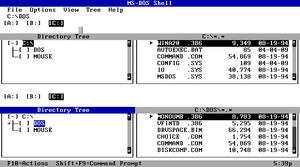- DOS Shell
-
The DOS Shell is a file manager, debuted in MS-DOS and IBM DOS (PC DOS) 4.0 (June 1988). It was discontinued after version 6.0, but retained as part of the "Supplemental Disk" until 6.22 for MS-DOS; as such, it was not a core part of the operating system throughout its evolution, but rather an add-on. It was, however, retained in IBM DOS and PC DOS through PC DOS 2000.
Features
The shell includes common features seen in other file managers such as copying, moving and renaming files as well as the ability to "launch" applications with a double-click. The shell could be run by the command "
dosshell". It had the ability to set simple colours and styles. The shell was one of the first successful attempts to create a basic graphical user interface (GUI) type file manager in DOS, although it is properly referred to as a text user interface (TUI) or Character Oriented Window (COW) even though graphical modes were available on supported hardware (VGA equipped PCs). The shell is very much like a DOS version of Windows File Manager.The shell also has a help system, "program list", and a "task swapper". Like modern file managers it had the ability to display dual hierarchy directory and file lists, i.e. left and right panes. The mouse was supported, however, like any other DOS application, it required an appropriate device driver.
One feature was the ability to list all files on a hard drive in a single alphabetized list along with the path and other attributes. This permitted the user to compare versions of a file in different directories by their attributes and easily spot duplicates.
Problems
There are several reasons why the shell fell out of use:
- It was incapable of multitasking, but did support rudimentary task switching. It could switch between programs running in memory, and even then the system would still take a significant performance hit. All the running programs had to fit into conventional memory, as there was no support for paging to disk.
- Windows 3.x, with its own graphical user interface, became much more popular among computer users. Windows was capable of multitasking. System performance was much higher, with complete access to the system's RAM.
See also
File managers Unix-like DOS Windows Altap Salamander · CubicExplorer · Directory Opus · FAR Manager · FreeCommander · SpeedCommander · STDU Explorer · Total Commander · Windows Explorer · WinSCP · xplorer² · XYplorer · ZTreeWinMac OS BeOS-like OpenTracker · TrackerCross-platform Categories:- DOS on IBM PC compatibles
- File managers
Wikimedia Foundation. 2010.

